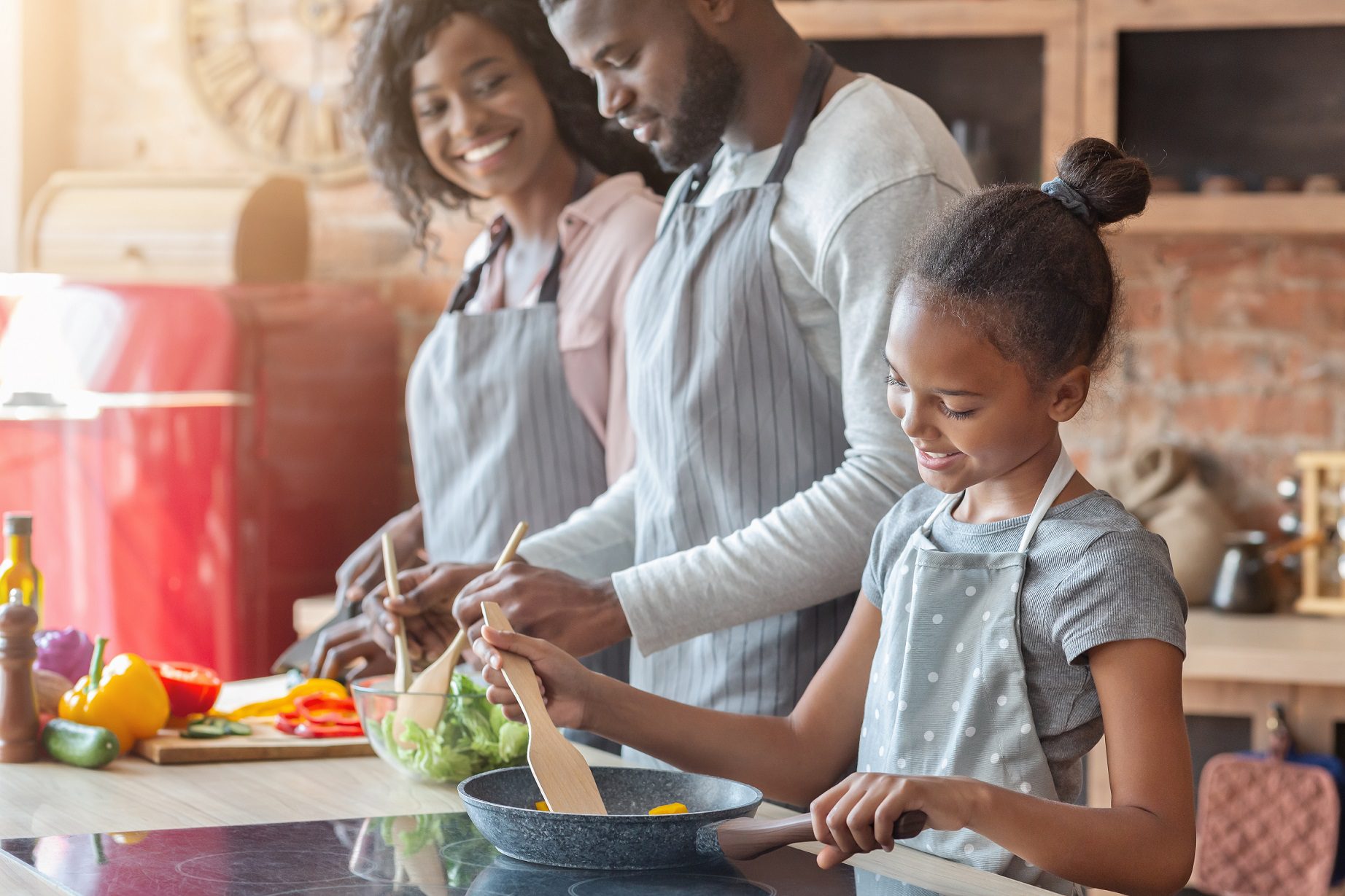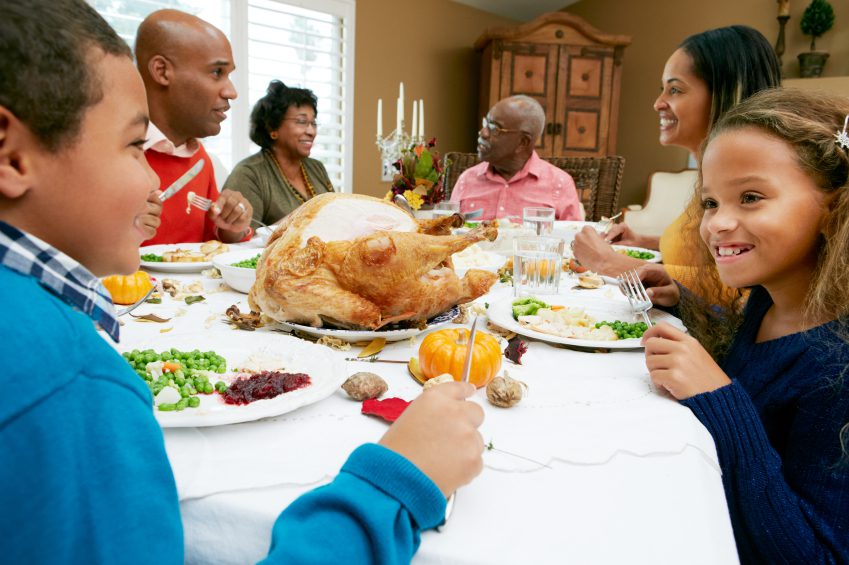Putting A Little Thanksgiving Into Your Nightly Family Dinners

Posted in: Hot Topics, Podcast, You & Your Family
Topics: Healthy Living, Relationships
Intro and outro written and performed by Dr. Gene Beresin.
When my colleague Kiley told me recently about her Thanksgiving tradition, she gave me some new ideas about family dinners—a subject I think about every night around 7pm, and with every patient I see in family therapy.
As a family therapist, I sometimes feel that I would go out of business if families had regular dinners with one another. Most families would be a lot better off it they just ate together. There are dozens of research studies that show that frequent family dinners promote kids’ mental health—by lowering rates of depression, anxiety, eating disorders and substance abuse, for starters. Family meals also strengthen children’s resilience, self-esteem and sense of connectedness to their parents. Isn’t that exactly what I’m trying to accomplish in therapy? It’s no wonder that I have to stifle the urge to say, ‘Stop wasting your time here. Go home and eat dinner together.’
But, I’m well aware of how hard it is for busy, harried families to find time to sit down to dinner, and I’m always looking for new ways to unlock the benefits without adding any guilt or pressure. So, that is why Kiley’s remarks struck a spark. Here’s what she said:
“My sisters and I love Thanksgiving so much that our father makes a Thanksgiving-like meal throughout the year that he dubs ‘harvest dinner.’ We just can’t get enough of his mashed potatoes!”
She added that she was especially excited this year because he had invited her to be his sous chef.
I love the idea of bringing Thanksgiving dinner to everyday meals. Why not bring some of the spirit (minus the heavy-lifting) of holiday cooking to our regular meals? Two elements in particular could easily translate to everyday dinners—sharing the workload, and focusing on more than the food.
All hands on deck.
Thanksgiving may be the mother of all family dinners, but it’s a meal that fathers, aunts, uncles, grandparents and kids all contribute to.
In my family, Thanksgiving is the only meal my husband takes the lead on. He buys, cooks and carves the turkey, and he recruits our sons to make an old-fashioned stuffing. The side dishes and desserts are my domain, but the cooking is, for once, shared equitably. Each of our guests brings a signature dish—homemade pies from my sisters-in-law, and two types of cranberry sauce from a friend.
However, here are ways you can spread out the work of dinner when it’s just a random weeknight:
- Don’t let any one person shoulder the workload (planning, shopping, cooking, cleaning up) of nightly meals. The more that family members participate, the more they become stakeholders who will feel committed to making time for dinner. While it can be extra work to supervise young kids while they stir the soup and crumble the cheese, it will get them in the habit of helping as they grow into more competent cooks.
- While men are featured as chefs on cooking shows, the workload they carry in most home kitchens has not kept pace. More women than men are still in charge of putting nightly dinner on the table. Just as women are encouraged to “lean in” at work, so should men be encouraged to lean in at home. Teaching your sons to cook can be a feminist act.
- Encourage your kids to choose meals they really enjoy, and see if they might take the lead in preparing them—or at least join in the cooking. Even if they just make a choice, it will prompt them to be present for the meal they love. Younger kids might choose a name or theme for the dinner, such as “The Sunday Special” or “Food for Thought.” This, too, is a part of contributing to the family process.
- In my work with The Family Dinner Project, we bring families together to cook, and share tips with them for how to overcome obstacles to create family dinners of their own. Recently, we were invited to Hanscom Air Force Base, where we learned about a new way to share the workload: each family makes four batches of a dinner, and then meets up with three other families who have made the same effort. The families swap dinners so that each now has four different dinners—with only one cooking episode required.
Food brings us to the table, but it’s the talk that keeps us there.
At Thanksgiving, there are usually extra people around the table to tell stories and contribute to discussion. Thanksgiving dinner tends to run much longer than the 22 minutes that is average for a nightly family dinner. During the rest of the year, you can help extend time spent at the table by playing games, asking interesting questions and telling stories.
- Bring some variety to the conversation. Instead of asking, “How was your day?” (which often elicits a conversation-stopping “fine” in return), you might ask everyone to describe their day in terms of a rose (something positive), a thorn (something difficult or challenging) and a bud (something hopeful). Or, cut up dozens of little strips of paper, and on each one, write a “conversation starter” (some examples: “Where do you feel most relaxed?” “What is your best personality trait?” “If you were an animal, what would you like to be?”). Then, stuff them into a jar or tissue box. When conversation lags, suggest that someone pull out a slip and answer the question. For more conversation starters and ways to deepen table conversation, check out tips at www.thefamilydinnerproject.org.
- Kids who know stories about their families are more resilient—and dinner is the main time we tell stories. At Thanksgiving, there are many food-themed stories to tell, such as what Thanksgiving dinner was like for the elders at your table when they were children. For the rest of the year, however, you might tell stories ranging from a favorite family recipe, to how family names were chosen, to how you and your partner fell in love.
As we all know, some kids, particularly teens, may be reluctant to talk. In fact, they may mutter a few insignificant words, roll their eyes and denounce the conversation altogether. Yet, kids love to hear stories about family history, and want to know about their parents’ lives. It’s kind of like jump-starting a car—it may be hard to turn over initially, but once it gets started, it just keeps on running. So, how can you get the conversation going? Think perhaps about a thought or observance from your day, a past experience, something relevant to the meal served, or any topic you feel would interest or amuse your kids. Then, start the dinner conversation with a story of your own. This modeling behavior can be great at getting the ball rolling.
What NOT to carry forward from Thanksgiving? Hours of cooking.
The many benefits of family dinner do not depend on serving organic arugula or making chicken stock from scratch. In fact, you can hate to cook and still love family dinners.
- Embrace shortcuts to cooking. For example, have breakfast for dinner. Now that eggs are in good standing, try baked eggs over wilted greens with a sprinkle of cheese. Or, opt to make lunch for dinner by serving soup and sandwiches.
- Make a double batch of soup or stew and freeze half of it. When you defrost next week, it’ll be like having a sidekick cook!
- Buy pre-made pizza dough and just add toppings. Or, you could buy a rotisserie chicken for one night, and use the leftovers for chicken noodle soup the next.
Like Kiley’s family, you, too, can have ‘harvest dinners’ all year ’round. In addition to those mashed potatoes, just be sure to add a side of story-telling, and everyone pitching in.

 Share
Share Tweet
Tweet





